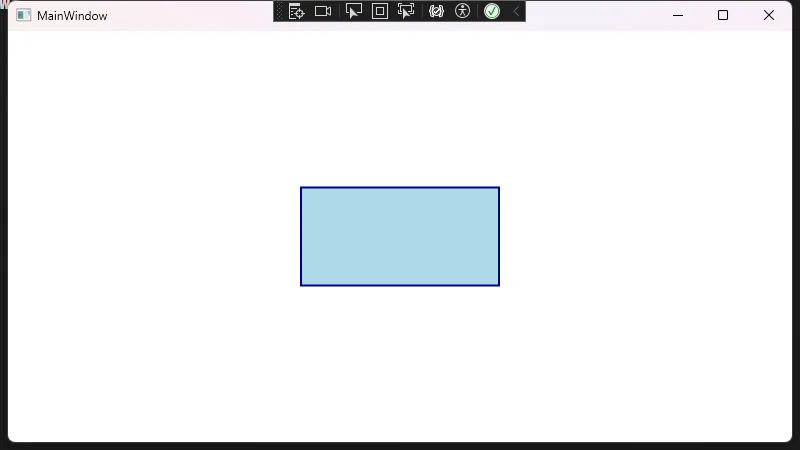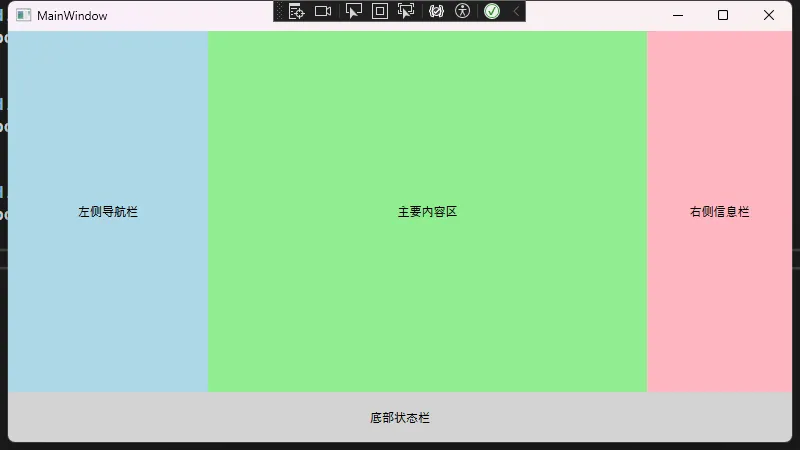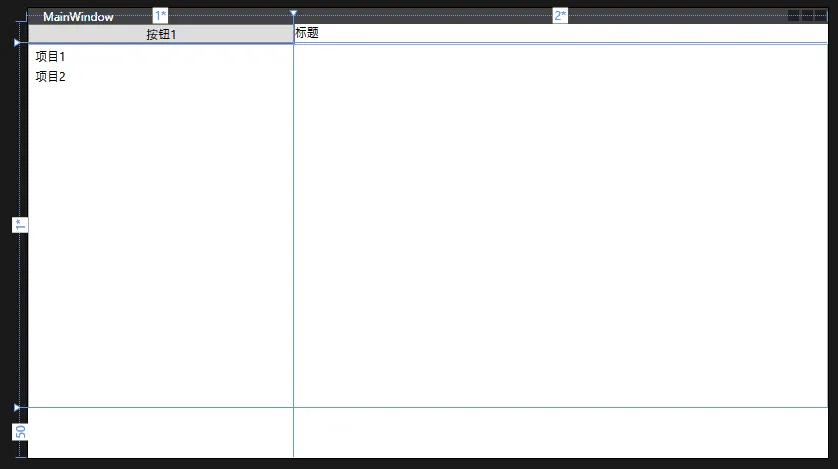在从 WinForm 向 WPF 转型的过程中,很多开发者都会思考如何在 WPF 中实现各种自定义图形的绘制。WinForm 中通常通过 GDI+或者直接在控件的 Paint 事件中手动绘图。而在 WPF 中,使用 Shape 派生类(例如 Rectangle, Ellipse, Line 等)就可以更直观地在界面上绘制图形。本篇文章将介绍如何在 WPF 中使用 Rectangle,并说明与 WinForm 的主要差异,以及如何利用 WPF 的强大样式和动画特性让矩形图形更灵活多变。
Rectangle 在 WinForm 与 WPF 中的差异
WinForm:
- 通常需要在
OnPaint或Paint事件内通过Graphics对象手动调用DrawRectangle等方法进行绘制。 - 若想改变矩形的位置、大小或颜色,通常需要触发重绘(
Invalidate/Refresh)或联动其它 UI 事件。
WPF:
- 通过
System.Windows.Shapes.Rectangle控件来绘制矩形。可以把它看作一个 UIElement,天然支持布局系统。 - 可直接在 XAML 中声明,或在后台代码创建并添加到容器中。
- 可以使用依赖属性(如
Width,Height,Fill,Stroke等)进行绑定或使用样式,轻松调整或动画化。 - 几乎无需手动处理重绘,WPF 会自动计算并渲染界面。
一个简单的 Rectangle 示例
下面是一个最基础的示例,展示如何在 XAML 中使用 Rectangle 控件:
XML<Window x:Class="AppRectangle.MainWindow"
xmlns="http://schemas.microsoft.com/winfx/2006/xaml/presentation"
xmlns:x="http://schemas.microsoft.com/winfx/2006/xaml"
xmlns:d="http://schemas.microsoft.com/expression/blend/2008"
xmlns:mc="http://schemas.openxmlformats.org/markup-compatibility/2006"
xmlns:local="clr-namespace:AppRectangle"
mc:Ignorable="d"
Title="MainWindow" Height="450" Width="800">
<Grid>
<Rectangle Width="200" Height="100"
Fill="LightBlue"
Stroke="DarkBlue"
StrokeThickness="2"
HorizontalAlignment="Center"
VerticalAlignment="Center" />
</Grid>
</Window>
 在此示例中:
在此示例中:
从WinForm转型到WPF开发时,最显著的变化之一就是布局系统的差异。WPF提供了更加灵活和强大的响应式布局能力,本文将详细介绍WPF中实现响应式布局的多种方式。
Grid布局 - 使用星号和Auto实现响应式
Grid是WPF中最灵活的布局容器之一,通过设置列宽和行高的比例,可以轻松实现响应式布局。
XML<Window x:Class="AppResponsive.Window1"
xmlns="http://schemas.microsoft.com/winfx/2006/xaml/presentation"
xmlns:x="http://schemas.microsoft.com/winfx/2006/xaml"
xmlns:d="http://schemas.microsoft.com/expression/blend/2008"
xmlns:mc="http://schemas.openxmlformats.org/markup-compatibility/2006"
xmlns:local="clr-namespace:AppResponsive"
mc:Ignorable="d"
Title="Window1" Height="450" Width="800">
<DockPanel LastChildFill="True">
<!-- 顶部工具栏 -->
<StackPanel DockPanel.Dock="Top" Background="LightBlue" Height="50">
<TextBlock Text="顶部工具栏" VerticalAlignment="Center" HorizontalAlignment="Center"/>
</StackPanel>
<!-- 左侧导航 -->
<StackPanel DockPanel.Dock="Left" Background="LightGreen" Width="150">
<TextBlock Text="左侧导航" VerticalAlignment="Center" HorizontalAlignment="Center"/>
</StackPanel>
<!-- 右侧面板 -->
<StackPanel DockPanel.Dock="Right" Background="LightPink" Width="200">
<TextBlock Text="右侧面板" VerticalAlignment="Center" HorizontalAlignment="Center"/>
</StackPanel>
<!-- 底部状态栏 -->
<StackPanel DockPanel.Dock="Bottom" Background="LightGray" Height="30">
<TextBlock Text="底部状态栏" VerticalAlignment="Center" HorizontalAlignment="Center"/>
</StackPanel>
<!-- 主内容区域(自动填充剩余空间) -->
<Grid Background="White">
<TextBlock Text="主内容区域" VerticalAlignment="Center" HorizontalAlignment="Center"/>
</Grid>
</DockPanel>
</Window>

前言
从WinForm转向WPF开发时,最需要转变的思维就是布局方式。WPF提供了更加灵活和强大的布局系统,可以轻松实现自适应布局设计。本文将详细介绍WPF中常用的布局控件及其应用。
Grid布局 - 最常用的布局控件
Grid是WPF中最灵活的布局控件,类似于HTML中的表格布局。它允许你定义行和列,并可以设置比例或固定大小。
基础Grid示例
XML<Grid>
<Grid.RowDefinitions>
<!-- 第一行高度为Auto,根据内容自动调整 -->
<RowDefinition Height="Auto"/>
<!-- 第二行高度为* ,占用剩余所有空间 -->
<RowDefinition Height="*"/>
<!-- 第三行固定高度50 -->
<RowDefinition Height="50"/>
</Grid.RowDefinitions>
<Grid.ColumnDefinitions>
<!-- 第一列宽度占比1 -->
<ColumnDefinition Width="*"/>
<!-- 第二列宽度占比2 -->
<ColumnDefinition Width="2*"/>
</Grid.ColumnDefinitions>
<!-- 放置在第0行第0列的按钮 -->
<Button Grid.Row="0" Grid.Column="0" Content="按钮1"/>
<!-- 放置在第0行,跨越2列的文本块 -->
<TextBlock Grid.Row="0" Grid.Column="1" Text="标题"/>
<!-- 放置在第1行,跨越2列的列表 -->
<ListBox Grid.Row="1" Grid.ColumnSpan="2">
<ListBoxItem>项目1</ListBoxItem>
<ListBoxItem>项目2</ListBoxItem>
</ListBox>
</Grid>

前言
从WinForm迁移到WPF是很多.NET开发者都会经历的过程。WPF提供了更强大和灵活的布局系统,但对于习惯了WinForm的开发者来说,可能需要一些时间来适应。本文将详细介绍WPF布局嵌套的核心技巧。
WPF布局容器概述
WPF主要的布局容器包括:
- Grid(网格布局)
- StackPanel(堆栈布局)
- DockPanel(停靠布局)
- WrapPanel(自动换行布局)
- Canvas(绝对定位布局)
从WinForm思维转变到WPF思维
WinForm的局限性:
C#// WinForm中的控件定位
button1.Location = new Point(100, 100);
button1.Size = new Size(80, 25);
WPF的优势:
XML<!-- WPF中的控件定位 -->
<Button Margin="100,100,0,0" Width="80" Height="25"/>
在WinForms中使用OxyPlot创建热力图的详细指南。热力图是一种非常有效的可视化工具,用于表示二维数据的密度或强度。它通过颜色变化来展示数据的分布情况,非常适合用于展示温度分布、人口密度、金融数据等多种场景。
准备工作
首先,我们需要在项目中添加OxyPlot的引用。您可以通过NuGet包管理器来安装OxyPlot。在Visual Studio中,右击您的项目,选择"管理NuGet包",然后搜索并安装以下包:
- OxyPlot.Core
- OxyPlot.WindowsForms
安装完成后,在您的代码文件顶部添加以下using语句:
C#using OxyPlot;
using OxyPlot.Series;
using OxyPlot.WindowsForms;
using OxyPlot.Axes;
创建基本热力图
让我们从一个简单的热力图开始。假设我们要展示一个5x5的温度数据矩阵。
C#public partial class Form1 : Form
{
public Form1()
{
InitializeComponent();
CreateBasicHeatMap();
}
private void CreateBasicHeatMap()
{
var plotView = new PlotView();
plotView.Dock = DockStyle.Fill;
var model = new PlotModel { Title = "基本热力图" };
// 创建热力图数据
double[,] data = new double[5, 5];
for (int x = 0; x < 5; x++)
{
for (int y = 0; y < 5; y++)
{
data[x, y] = Math.Sin(x * 0.5) * Math.Cos(y * 0.5);
}
}
var heatMapSeries = new HeatMapSeries
{
X0 = 0,
X1 = 4,
Y0 = 0,
Y1 = 4,
Interpolate = true,
RenderMethod = HeatMapRenderMethod.Bitmap,
Data = data
};
model.Series.Add(heatMapSeries);
// 添加颜色轴
model.Axes.Add(new LinearColorAxis { Position = AxisPosition.Right, Palette = OxyPalettes.Rainbow(100) });
plotView.Model = model;
this.Controls.Add(plotView);
}
}
